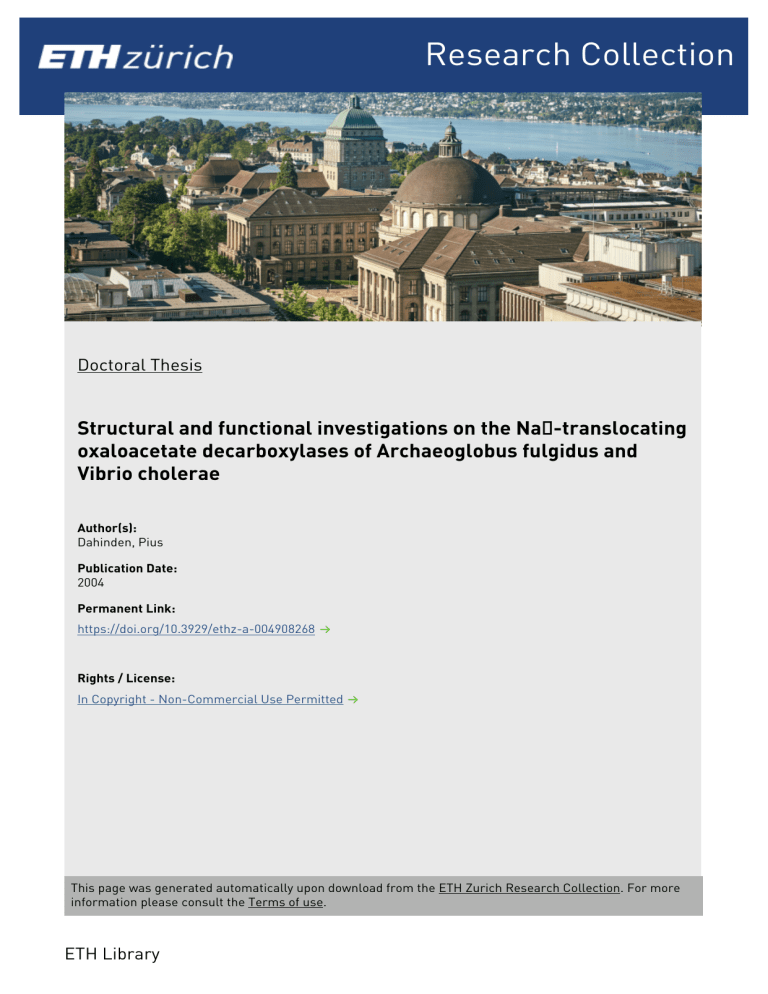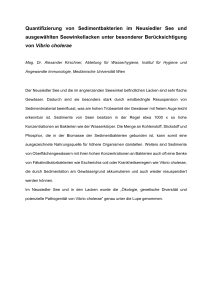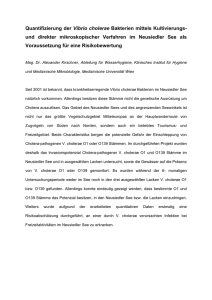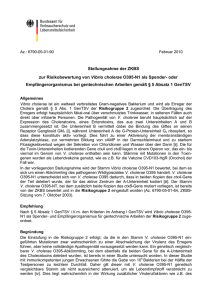Structural and functional investigations on the Na - ETH E
Werbung

Research Collection Doctoral Thesis Structural and functional investigations on the Na�-translocating oxaloacetate decarboxylases of Archaeoglobus fulgidus and Vibrio cholerae Author(s): Dahinden, Pius Publication Date: 2004 Permanent Link: https://doi.org/10.3929/ethz-a-004908268 Rights / License: In Copyright - Non-Commercial Use Permitted This page was generated automatically upon download from the ETH Zurich Research Collection. For more information please consult the Terms of use. ETH Library Diss. ETH No. 15827 Structural and functional investigations on the Na+-translocating oxaloacetate decarboxylases of Archaeoglobus fulgidus and Vibrio cholerae A dissertation submitted to the SWISS FEDERAL INSTITUTE OF TECHNOLOGY ZÜRICH for the degree of DOCTOR OF SCIENCES presented by PIUS DAHINDEN Dipl. Natw. ETH ETH Zürich Born November 11, 1973 from Egolzwil (LU) and Entlebuch (LU) accepted on the recommendation of Prof. Dr. Peter Dimroth, examiner Prof. Dr. Hubert Hilbi, co-examiner Zürich, 2005 1 Zusammenfassung Zusammenfassung Enterobakterien wie Klebsiella pneumoniae und Salmonella typhimurium oder das marine Bakterium Vibrio cholerae können in Abwesenheit von Sauerstoff mit Citrat als einziger Kohlenstoff- und Energiequelle wachsen. Schlüsselenzyme des Na+-abhängigen Citratfermentationswegs sind die Citrat Lyase und die Oxalacetat Decarboxylase. Die Oxalacetat Decarboxylase (OAD) gehört zur Familie der Na+-abhängigen CarboxylsäurenDecarboxylasen (Na+-translocating carboxylic acid decarboxylases, NaT-DC), welche freie Decarboxylierungsenergie in einen elektrochemischen Na+-gradienten umwandeln. Die meisten OADs bestehen aus zwei membranständigen Untereinheiten (β und γ) und einer cytosolischen α-Untereinheit. Die β-Untereinheit, welche die mit dem Transport von Na+-Ionen gekoppelte Decarboxylierung von Carboxybiotin katalysiert, ist ein stark hydrophobes, integrales Membranprotein bestehend aus 9 transmembranen α-Helices und einem hydrophoben Segment, das in die Membran inseriert ist, diese aber nicht vollständig durchdringt. Die periphere α-Untereinheit besteht aus der N-terminalen CarboxyltransferaseDomäne, welche die Carboxylgruppe von Position 4 von Oxalacetat auf die prosthetische Biotingruppe der Biotin-bindenden Domäne überträgt. Diese beiden Domänen sind über zwei flexible Linker-Peptide mit der Assoziations-Domäne verbunden, welche für die Bindung der α-Untereinheit an die γ-Untereinheit verantwortlich ist. Die γ-Untereinheit ist mittels einer einzigen α-Helix in der Membran verankert, über die sie mit der β-Untereinheit interagiert und mit ihr einen βγ-Subkomplex bildet. Die lösliche, cytosolische Domäne der γ-Untereinheit weist an ihrem C-terminalen Ende ein Zinkbindungsmotiv auf. Das an diese Domäne gebundene Zn2+-Ion beschleunigt nachweislich die Carboxyltransferreaktion. Die C-terminale Domäne der γ-Untereinheit interagiert spezifisch mit der Assoziations-Domäne der α-Untereinheit und vermittelt so den Zusammenhalt des OAD-Komplexes. In V. cholerae wurden zwei oad-Gencluster identifiziert, die oad-1 und oad-2 genannt wurden. Die oad-2-Gene sind Teil des Citrat-Operons von V. cholerae, während die oad-1Gene in einer genetischen Umgebung liegen, deren Gene nicht mit einem spezifischen Fermentationsweg verbunden sind. Beide oad-Gencluster von V. cholerae wurden kloniert und in Escherichia coli exprimiert. Pro Gramm Zellen wurden bis zu 0.4 mg OAD-1 mit einer maximalen spezifischen Aktivität von 8 U/mg gereinigt. Von der OAD-2 wurden bis zu 0.8 mg pro Gramm Zellen mit einer spezifischen Aktivität von bis zu 80 U/mg gereinigt. Die heterolog in E. coli exprimierte OAD-2 hatte dieselbe spezifische Aktivität wie das aus V. cholerae gereinigte Enzym. Das pH-Optimum der OAD-2 lag bei pH 6.5. Das Chromato- 2 Zusammenfassung gramm der Gelfiltrationsanalyse der affinitätschromatographisch gereinigten OAD-2 zeigte ein einzelnes, symmetrisches Signal, das einer apparenten Molekularmasse von 570 kDa entspricht. Da die berechnete Molekularmasse eines einzelnen OAD-Moleküls 121 kDa beträgt, liegt das native Enzym daher wahrscheinlich als Tetramer vor. Die Differenz zwischen der Masse des Tetramers und der apparenten Molekularmasse entspricht der Masse der Brij58-Detergens-Micelle. Eine besondere Eigenschaft der Oxalacetat Decarboxylase ist ihre Aktivierbarkeit durch Na+-Ionen: in Abwesenheit von Na+-Ionen ist die OAD-2 inaktiv. Mit steigender Na+Konzentration nimmt die Aktivität zu. Bei 1 mM NaCl ist die Aktivierung halbmaximal, bei 10 mM wird Sättigung erreicht. Die gemessenen Daten passen am ehesten zu einem Kurvenverlauf, der sich aus der Hill-Gleichung ergibt. Der entsprechende Hill-Koeffizienten beträgt 1.8, was darauf hinweist, dass mindestens 2 Na+-Ionen kooperativ an das Enzym binden. Durch hohe Na+-Konzentrationen (> 200 mM) wird das Enzym gehemmt, wobei die Aktivität bei 1 M NaCl weniger als 10% der maximalen Aktivität beträgt. Der durch die OAD-2 katalysierte Transport von Na+-Ionen wurde mit einer kontinuierlichen Untersuchungsmethode nachgewiesen, indem die Na+-Aufnahme in Proteoliposmen verfolgt wurde, in deren Lumen der Na+-sensitive Fluorophor Natriumgrün eingeschlossen war. Eine Voraussetzung für den gekoppelten Transport von Na+ durch die Oxalacetat Decarboxylase ist die Bindung der α-Untereinheit an den βγ-Komplex. Es wurde bereits früher mit dem Klebsiella-Enzym gezeigt, dass einer der vier Histidin-Reste am C-Terminus der γ-Untereinheit essentiell für diese Reaktion ist. Auch die γ-Untereinheit der OAD-2 von V. cholerae besitzt drei Histidin-Reste an ihrem C-terminalen Ende, von denen einer (H81) an der Interaktion mit der α-Untereinheit beteiligt ist. Um die Bindungsregion der α-Untereinheit zu bestimmen, die mit der γ-Untereinheit intergiert, wurden eine Reihe von Deletionsmutanten erzeugt und zusammen mit der C-terminalen Domäne der γ-2-Untereinheit (γ'-2) exprimiert. Darauf wurden die Proteine entweder über den His-Tag der γ-Untereinheit oder über die prosthetische Biotingruppe der α-Untereinheit affinitätschromatographisch gereinigt. Im Falle einer Co-Reinigung der beiden Proteine wurde geschlossen, dass diese als Komplex vorliegen. Mit Hilfe dieser Strategie wurde ein Bereich von 40 Aminosäuren innerhalb der α-Untereinheit identifiziert, der für die Komplexbildung mit der γ-Untereinheit notwendig ist. Dieses Peptid repräsentiert eine gesonderte Domäne innerhalb der α-Untereinheit, die Assoziations-Domäne genannt wurde. Diese Assoziations-Domäne ist an ihrem N-Terminus mit einem flexiblen Linker-Peptid mit der Carboxyltransferase-Domäne verbunden und an ihrem C-Terminus über einen weiteren flexiblen Linker mit der biotinbindenden Domäne. 3 Summary Summary Some enterobacteria like Klebsiella pneumoniae and Salmonella typhimurium or the marine bacterium Vibrio cholerae are able to grow under anoxic conditions on citrate as sole carbon and energy source. Key enzymes of the Na+-dependent citrate fermentation pathway are citrate lyase and oxaloacetate decarboxylase. The oxaloacetate decarboxylase (OAD) is a member of the Na+-translocating carboxylic acid decarboxylase (NaT-DC) family of enzymes that convert the free energy of decarboxylation into an electrochemical gradient of Na+. Most OADs are composed of two membrane-bound subunits (β and γ) and a cytosolic α-subunit. The β-subunit, which catalyzes the decarboxylation of carboxybiotin coupled to the transport of Na+ ions, is a highly hydrophobic integral membrane protein consisting of 9 transmembrane α-helices and a hydrophobic segment inserted into the membrane but not traversing it. The peripheral α-subunit is composed of the N-terminal carboxyltransferase domain catalyzing the transfer of the carboxyl group at position 4 of oxaloacetate to the prosthetic biotin group of C-terminal biotin-binding domain. Via flexible linker peptides these two domains are connected to the association domain interacting with the γ-subunit. The γ-subunit is anchored in the membrane by a single α-helix and interacts via this transmembrane segment with the β-subunit to form a βγ-subcomplex. The soluble, cytosolic domain of the γ-subunit possesses at its C-terminal end a zinc binding motif. The Zn2+ ion bound to this motif was proven to accelerate the carboxyltransfer reaction. Moreover, this C-terminal domain of the γ-subunit specifically interacts with the biotin-binding domain of the α-subunit. The γ-subunit therefore mediates the coherence of the OAD complex. In V. cholerae two copies of oad gene clusters have been identified, termed oad-1 and oad-2. The oad-2 genes are part of the citrate operon of V. cholerae, whereas the oad-1 genes are located in a region of genes not associated with a specific fermentation pathway. Both oad genes from V. cholerae were cloned and expressed in Escherichia coli. Per gram of cells up to 0.4 mg OAD-1 were purified with a maximal specific activity of 8 U/mg. On the other hand up to 0.8 mg OAD-2 with a specific activity of up to 80 U/mg were purified per gram of cells. The OAD-2 which was synthesized heterologously by E. coli had the same specific activity as the enzyme purified from V. cholerae cells. The pH optimum of the OAD-2 was pH 6.5. The affinity-purified OAD-2 moved as a single symmetrical peak on a size exclusion chromatography column with an apparent molecular mass of 570 kDa. As the calculated molecular mass of a single OAD molecule is 121 kDa, the native enzyme presumably is a 4 Summary tetramer. The difference in the determined and calculated mass represents the mass of the Brij58 detergent micelles. A peculiar property of oxaloacetate decarboxylase is its specific activation by Na+ ions: In the absence of Na+ ions the OAD-2 is inactive, but the activity increases with increasing Na+ concentration to reach half-maximal activation at 1 mM and saturation at about 10 mM NaCl. The measured data fit best to the Hill equation with a Hill coefficient of 1.8, indicating that at least two Na+ ions bind to the enzyme in a cooperative manner. At high concentrations of Na+ (> 200 mM), however, the enzyme becomes inhibited to reach less than 10% of the maximal activity at 1 M NaCl. Transport of Na+ ions by the enzyme was shown in a continuous assay with the Na+ sensing fluorophore Sodium Green enclosed in proteoliposomes containing the reconstituted OAD-2 in their membrane. A prerequisite for the coupled transport of Na+ by the OAD is the binding of the α-subunit to the βγ-complex. It was shown previously with the Klebsiella enzyme that one of the four histidine residues at the C-terminus of the γ-subunit is essential for this interaction. Similarly, subunit γ of OAD-2 from V. cholerae contains three histidine residues at its C-terminal end, and one of these (H81) is involved in complex formation with the α-subunit. To identify the binding region on the α-subunit that interacts with the γ-subunit, a series of deletion mutants was generated and expressed together with the C-terminal domain of the γ-2-subunit (γ'-2). Subsequently, one of the co-expressed proteins was purified by affinity chromatography either via an attached His-tag or via the prosthetic biotin group, and complex formation was assessed by the co-purification of the other subunit. With this strategy a stretch of 40 amino acids within the α-subunit was identified that is required for complex formation with the γ-subunit. This peptide represents a separate domain of the α-subunit that has been termed association domain. The association domain is linked at the N-terminus via a flexible linker peptide to the carboxyltransferase domain and at the C-terminus via a second flexible linker peptide to the biotin carrier domain.


